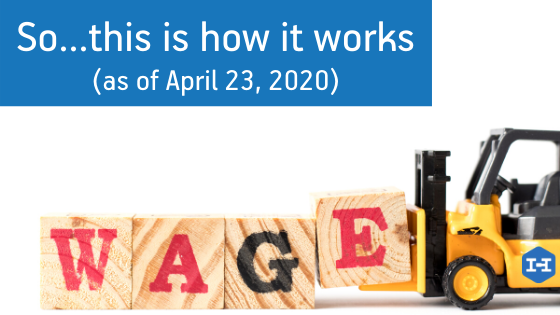Wage Subsidy…This is how it works
Yes, this is another long blog post. If you’re planning a claim, we suggest you print this off and work through it by section.
And yes, it’s complicated. (If you think this is bad, try reading the actual legislation at Bill C-14 431 A second Act respecting certain measures in response to COVID-19 | Projet de loi C-14 431 Loi no 2 concernant cert).
We apologize for any inconvenience caused….
This is CRA’s key webpage. We summarize and comment on it below, but please review this webpage before you start.
https://www.canada.ca/en/revenue-agency/services/subsidy/emergency-wage-subsidy.html
1.First step – How do you determine if your business is eligible?
- Almost any business is potentially eligible to apply, so long as it has a payroll account set up with CRA as at March 15, 2020
- You need to have suffered the required reduction in revenue (15% in March, 30% in April or May).
- See the section “What is an eligible revenue reduction” in the key webpage at the top of this message. Note that you have to pick a calculation method in month 1 and stick to it.
- The website tells you to use your normal accounting method when calculating revenue. However, the legislation does allow you to elect to measure your revenue on a cash basis (money received) versus an accrual basis (money billed or earned).
- Be clear that CRA has divided the subsidy into 4-week “Periods”. The revenue relevant to a particular period is calculated on a calendar month. That makes you eligible to claim the subsidy for payroll paid in a 4 week period that partly overlaps – see more below.
- Be clear about the criteria for automatically qualifying for the next period, and the payroll to which it relates.
- If you suffered a 15% revenue hit in Period 1 (based on March revenues), you’re eligible to claim in that period. That means you can claim the subsidy for payroll between March 15 and April 11, 2020.
- You’re also deemed to have suffered the required 30% revenue hit in Period 2, so you don’t have to calculate your eligibility again. However, your payroll numbers – and thus your subsidy – will be different next month (between April 12 and May 9, 2020). So you will need to apply again for Period 2, although you don’t have to crunch the revenue numbers to check that you’re eligible.
- Being eligible in Period 1 (and thus into Period 2) doesn’t automatically make you eligible for Period 3. You need to calculate your revenue hit for April (Period 2) or May (Period 3), to work that out. If you are eligible, then Period 3 covers payroll paid between May 10 and June 6, 2020.
All clear?
2.Who are eligible employees (for whom you can claim the subsidy)?
- See the CRA website link. The government is encouraging you to hire people back, who you may have laid off, or placed on unpaid leave.
- Note that you have to have paid someone for at least half of the Period in question, for you to be able to claim the subsidy. Having put them on unpaid leave doesn’t count. However, you can pay them retroactively (back pay), so that they qualify – even if they were sitting at home.
- The first period (March 15 to April 11) has already closed, so you’ll have to do the math to work out if the dates fit, or if you’ll need to do a retroactive pay.
- We’re now in the 2nd period. If you haven’t yet hired an employee back, you’ll need to do so by April 25 (this Saturday) if you want to be able to claim subsidy for them in Period 2 – or backdate their pay to Saturday 25th or earlier.
- Beware that if you hire back an employee who’s already claimed the CERB, s/he may have to repay that benefit. Make sure your employees are aware of that. They can do it now, but it’s safe to assume that the government will find a way to track people down, if they don’t. Eventually (probably via 2020 tax returns). Here’s more detail on how to repay CERB: https://www.canada.ca/en/revenue-agency/services/benefits/apply-for-cerb-with-cra.html?employee=I%20was%20self-employed#return)
- And a reminder: technically, the business owner (or related people) may also be an employee of the relevant business (taking a T4), or may not be (taking a T5). To be an eligible employee, any non-arm’s-length person had to already be on payroll as at March 15. No adding yourself on at the last moment, just to be eligible or increasing your pay. Sorry, they got that one.
3.What’s the amount of payroll on which I can claim subsidy?
We tried this out on ourselves, and it was more complex than we hoped it would be. Here goes…
- There are lots of different ways in which you can compensate employees, in addition to a base wage or salary.
- Most but not all of these compensation methods can be included when you’re calculating the subsidy to claim. The general rule is that if you would be required to deduct and remit tax on the compensation (so that includes overtime, vacation pay, commissions), then it’s good.
- It does mean that you can’t include severance pay, or most non-cash benefits like personal use of a corporate car, when you’re calculating the amount to claim subsidy on.
- Also, you can’t exceed the weekly average pay between Jan 1 – March 15, 2020 – unless people are actually working more hours than in that period. If your staff are not working or are working short hours, you use that average number as a proxy and pay them at least 75% of that average. 75% is what you’ll be reimbursed. Ignore any full week when there was no pay, when you’re working out this weekly average. (So, that takes account of full weeks off – or people you only hired in 2020.)
- Be careful to get the days right – this can be complex, if you’ve laid people off and are rehiring.
- The legislation refers to “eligible remuneration”…..but the spreadsheet provided by CRA refers to “weekly gross pay”. We interpret this as meaning wages paid or payable for the days within that period, regardless of when you actually cut the cheque to your employee.
- This means you may have to do some digging, to get the right numbers. For example, the wages earned on Monday through Sunday of this week may be paid out on Friday next week. Be careful to pick the correct pay period dates from your payroll system, rather than using the payment date.
- You may have two different pay cycles. For example, at H&Co, our full-time people are on salary, paid twice monthly. Our part-time staff are paid every 2 weeks. Use the different tabs on the CRA spreadsheet for the different pay cycles.
- Just to add to the fun, the CRA Periods don’t necessarily align with your pay periods. Try to line up the amounts earned to CRA’s Periods.
- In a perfect world, you’d go back to timesheets to work that out.
- In the real world, you can probably get away with calculating the right number of days that fall out of a particular pay period but there’s no guidance on this on the CRA website.
- What do I mean? Say your employee earned $700 in the period from April 8 to 14, paid on April 19. The period ends April 11…. So 4 days falls within this period, and your subsidy will be based on $400 or [4/7 x $700]. The other $300 falls into next month’s claim, if you’re eligible.
- The same principle applies when you are working out which payruns you need to look at, when you’re working out the Jan 1 to Mar 15 baseline.
- Also note that there’s potentially different treatment between an employee who is arm’s length from the company (a “normal” employee) and one who is not (typically, the owner or a family member). There are restrictions on the latter, again to prevent people abusing the system by boosting their payroll – they shouldn’t catch “honest” situations.
- Recall that the government will cover 75% of the pre-crisis cost…. You are encouraged to try to top it up to 100%, but that is your call. See earlier blog posts.
4.I hate math. Do I have to calculate the subsidy amount myself?
Well, yes and no. You have to be able to input the data into the tools that CRA has provided…
CRA’s provided you an excel spreadsheet to calculate the amount you can claim, based on information from your pay system. You can download it from the webpage (or use it in Google sheets etc.). We’ve played with it for a few minutes… but we’ve assumed that the government has checked it for integrity before posting it. Make sure to print or (preferably) save it once you’ve done!
Then:
- take the calculated outputs from the front page (don’t worry, they’re very obvious), and key them into the CRA online form
- add the employer’s CPP and EI contributions that were made on employees who were “on leave with partial or full pay” for the whole week – you can’t include in your claim the employers’ contribution for people who are still working (the idea being that you’re not out of pocket for anything, when you’re paying people to not work)
- deduct what you may already have claimed under the original 10% subsidy [see our earlier post if you can’t remember this]
- adjust for anything under work-sharing (unlikely in most cases)
….. And hit “calculate”!
….and print as well!
That’s not it – though…. that gives you the amount you can claim. Then, you actually apply for the subsidy.
5.How do you actually apply for the subsidy?
- You may have “My Business Account” already set up. If so, you will apply through that.
- If you don’t, then there will be a separate online application form that opens on April 27.
- The CRA website says that you will need a web access code to use it. See here for how to get one
- https://apps.cra-arc.gc.ca/ebci/leb0/wacretrieve/pub/disclaimer.action?request_locale=en
- You will need your 9-digit business number and add “RP0001” to the end of it
- You will need a return filed last year. We suggest your T4SUM, as many of you will already have found that in order to apply for the CEBA ($40k loan).
- If neither of the above work…. If you’re an existing client, we will have access to your CRA account, and we can do it for you – but please refer to the covering email which may have directed you to this blog post.
- We understand that funds will flow in May, and then monthly after that. One of the purposes of the $40k CEBA is to help you to bridge to that subsidy coming in.
We suggest that you clear a block of time to do this – it’s not as simple as it might be – and have a strong cup of coffee on hand. Or perhaps, a large glass of wine or beer.
Note the scary disclaimers at the foot of the webpage. Don’t try to abuse the system. But…. the financial help can be significant, so it’s worth doing it right.

